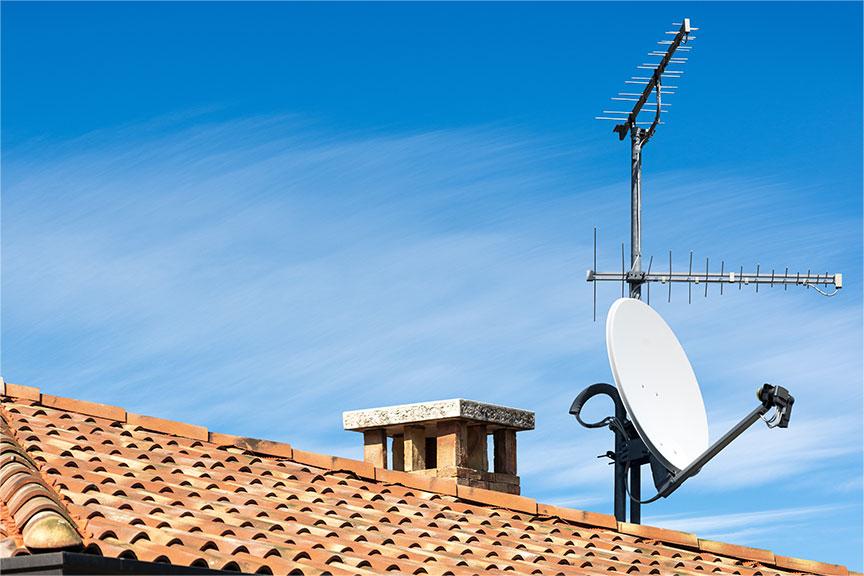One summer day, when I was a little girl, I asked my papa
how our TV antenna worked. He explained that it
was powered by a little elf who lived inside the TV and made the pictures move.
Obviously, my papa was joking.
Then guess what happened?
I did a test.
I placed a marshmallow on top of the TV and waited for the elf to come out and grab it.
Of course, the marshmallow remained untouched. My papa had a big laugh at my action, but
he also took the time to explain how a TV antenna
really works.
Who knows? Now I'm an expert on TV antennas, and I'm here to share everything I've
learned about
TV
antennas with you.
What is a TV Antenna?
To start, let's take a look at what a TV antenna is.
A TV antenna is a metal rod or dish that is used to receive television signals from a
broadcast tower. Antennas come in different sizes and shapes and can be placed outside
or inside. Outdoor antennas are typically larger and more powerful than internal
antennas and are mounted on roofs or attics. Indoor antennas are smaller and less
powerful and are always inside the television.
TV antennas are used to receive both digital and analog television signals. Digital
television signals are transmitted using a different technology than analog signals and
require a different type of antenna. Most TV antennas can receive both signals, but some
are designed specifically for digital or analog signals.
Sounds cool, isn't it?
Also, there are a variety of TV antennas on the market, and your location and the
signal's strength will determine the type you require. If you live in the countryside,
you will need a more powerful antenna than in a city. They are a vital part of any home
entertainment setup.
Next, we'll cover how a TV antenna works, starting with receiving the signal.
How does a TV Antenna Receive
Signals?
Let me tell you how a
TV antenna
receives signals. TV antennas receive signals through a process called
electromagnetic induction. Electromagnetic induction is the process of using a magnetic
field to generate an electric current in a conductor. The antenna uses a metal rod to
receive the magnetic field from the broadcast tower and converts it into an electric
current. The electric current is then sent to the TV through a coaxial cable.
But stick with me for a moment.
Because...
Many factors affect the antenna signal strength, including distance, antenna quality,
weather, interference, etc. To receive the strongest possible signal, it is often
necessary to experiment with the placement of the antenna.
After receiving the signal, the TV antenna will start to transmit the signal. How is
this achieved? Then read on.
What is the Working
Principle of TV Antennas?
Here comes the most interesting part - the working principle of TV antennas. A TV
antenna captures the electromagnetic waves from the television station and converts them
into electrical signals that the TV can receive.
The antenna is designed to be directional, meaning it is more sensitive to signals from
a particular direction. The antenna also has an amplifier that boosts the signal
strength, allowing it to capture weak signals.
Moreover, the antenna is also designed to be tuned to the frequency of the television
station. This allows an antenna to pick up the signals from the desired station and
reject signals from other stations. In addition, most TV antenna includes a filter that
helps reduce interference from other sources, such as cell phones and radio
stations.
With a TV antenna, people can watch their favorite shows and stay updated with the
latest news and events. Now you know how it works, but it's not enough! You won't be
able to find the best one until you learn about the types of TV antennas
thoroughly.
What Types of TV Antennas Are There?
There are many different types of TV antennas available on the market today. Each type of
antenna has its own set of benefits and drawbacks.
1. Indoor antennas. The most common type is the
indoor antenna, designed to be placed inside the home and is typically the most
affordable option.
2.
Outdoor antennas. The larger and more
powerful one is the
outdoor antenna. They are designed to be mounted outside the
home. These antennas are typically more expensive, but they can provide better reception
in areas with weaker signals.
3. Multi-directional antennas. They are
designed to pick up signals from multiple directions and are often used in rural areas
where signals may be weak.
4. Amplified antennas. The last popular one is
amplified antennas. They are designed to boost the signal strength of weaker signals and
are often used in areas with weak signals.
No matter what kind of antenna you choose, you need to ensure it works with your TV and
is set up correctly for the best reception.
Conclusion
In conclusion, TV antennas are a great way to access free over-the-air television
signals. Understanding how a TV antenna works is important for
getting the best
reception and ensuring you get the most out of your antenna. With the right antenna
installed, you can watch free TV without paying for an extra cable or satellite
subscription.
Now, go check out the
best
TV antennas for 2023 we tested for you, and enjoy a premium TV experience!
